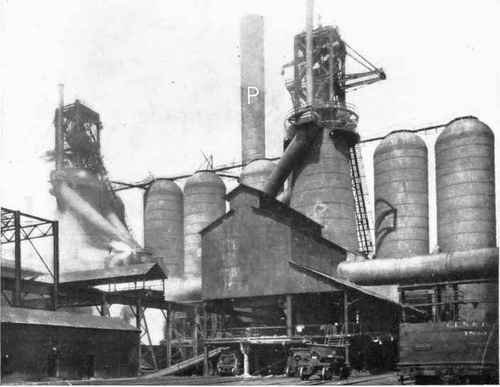57. Blast Furnace Operation
Description
This section is from the book "An Elementary Outline Of Mechanical Processes", by G. W. Danforth. Also available from Amazon: An elementary outline of mechanical processes.
57. Blast Furnace Operation
This description applies particularly to iron smelting, but it is also the essential part of blast furnace operation for smelting other ores. The starting of a blast furnace in operation is called "blowing in." A light fire is started in the hearth and is for a while supplied only with enough fuel to keep it going. Care must be taken to heat up and dry out the furnace very slowly to avoid cracks in the newly built or repaired parts, or in the slag coating which acts as a protection to the furnace walls. Very gradually the quantity of fuel is increased and when it is above the tuyeres, a light blast is started to increase combustion. After a few weeks, with a large iron smelting furnace, the shaft becomes well filled with fuel and the heat has reached a maximum.
A little slag from the slag dump is now added. This melts and runs down, covering the bottom of the hearth and keeping it hot,

Fig. 6b. - Top of a Blast Furnace.
A - Charging car.
D - Furnace shaft casing.
G - Down comer. N - Bell lever.
R - Stand pipe.
The tap hole is stopped with clay. Ore and flux are added, the blast pressure is increased to that desired, and the furnace soon reaches a condition of maximum output. The furnace may be kept in operation for months without cessation, until it must be stopped for relining or repairs. When in operation, the furnace is charged at intervals of a few minutes with a layer of coke and then a layer of flux and ore. The material is sprayed with water, hoisted to the top of the furnace, and dumped into the cone. The water prevents the carrying of an excessive amount of dust from the furnace into the "down comer." In Fig. 6b, the charging car A has just reached the top of its track and is about to be automatically dumped into the hopper over the cone.

Fig. 7. - Blast Furnaces and their Hot Blast Stoves.
The air blast is supplied by a centrifugal or other form of blower, and is forced through coils of heated pipe for lead and copper, or through a large stove (called a regenerative or hot-blast stove) for iron, entering the furnace at a high heat through the hot-blast main and tuyeres. The most intense heat of the furnace begins immediately above the tuyeres and extends up as far as the oxygen lasts for the complete burning of the fuel. This is called the fusion zone.
The ore heated above the fusion zone disintegrates, is reduced, giving up its gangue to the action of the flux, and as it sinks into the zone of fusion, it gradually melts. The metal, more or less impure, trickles to the hearth, and the slag also runs down, floating on top of the metal. When the slag rises to the level of the cinder-notch it runs out, and the metal is tapped out before it is high enough to reach the cinder notch. Care is always taken to leave a covering of slag over the metal. The slag, drawn off at the rear or side of the furnace, is conveyed along a trough or trench into cars with sheet steel bodies, and is hauled away and dumped when cool. Slag of some compositions is now used for making Portland cement. The metal is tapped several times during each day, and is conducted from the furnace along a trench in the floor. This trench is lined with a mixture of sand and clay which is baked hard to prevent wearing away by the erosive action of the metal. Fig. 16 shows metal pouring from a furnace, and Fig. 17 shows the ladles on cars to receive it.
When a furnace is to be shut down, or "blown out," the ore charge is gradually reduced and stopped. Flux and fuel are continued until all metal and slag are tapped out, and the flux is then discontinued. The fuel is gradually reduced, the blast pressure is lowered and finally shut off, and the fire slowly burns out. The furnace must be allowed to cool gradually before being emptied.
Continue to:


